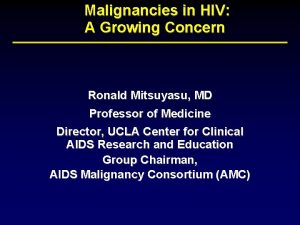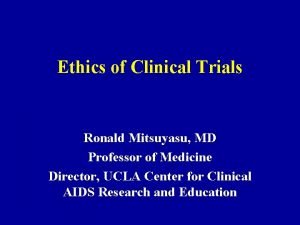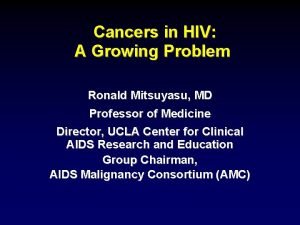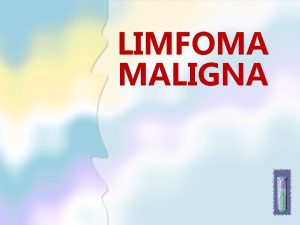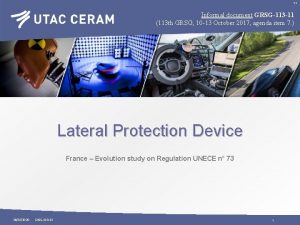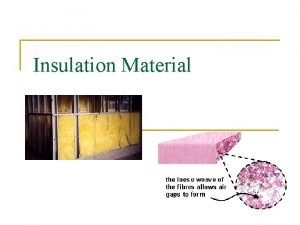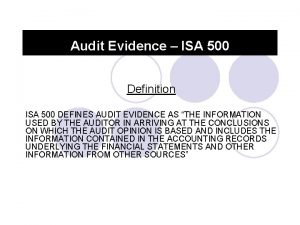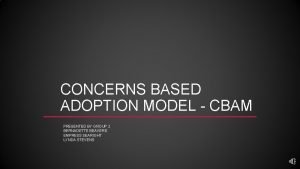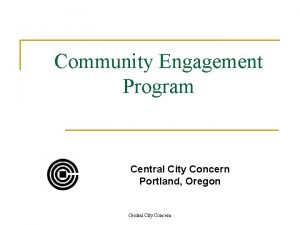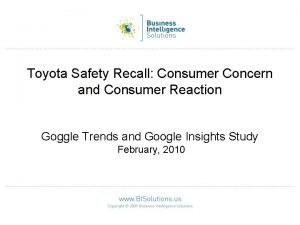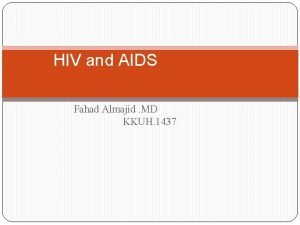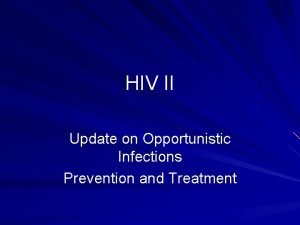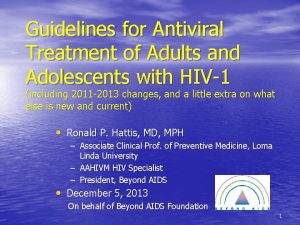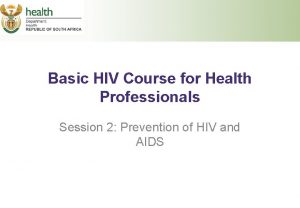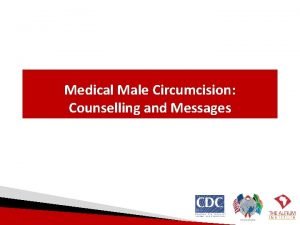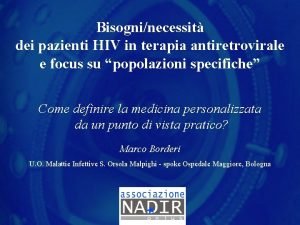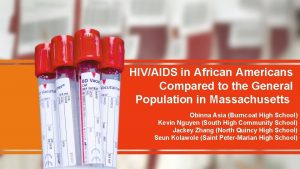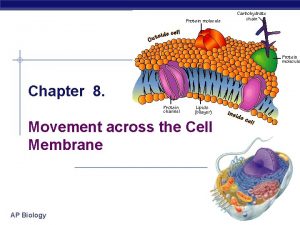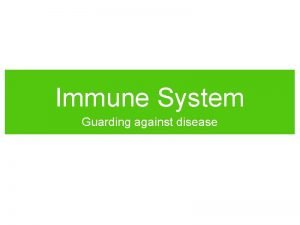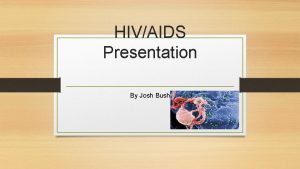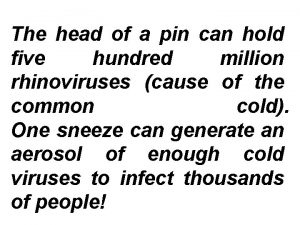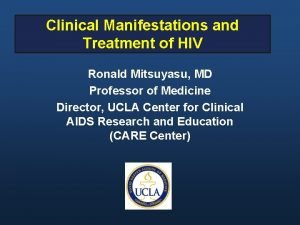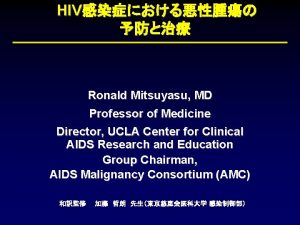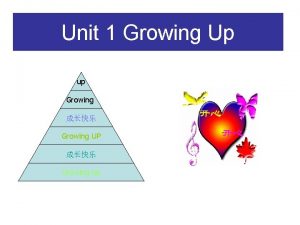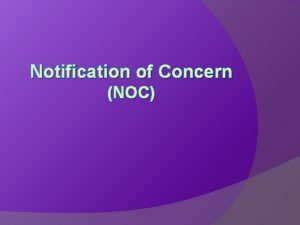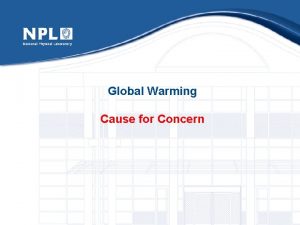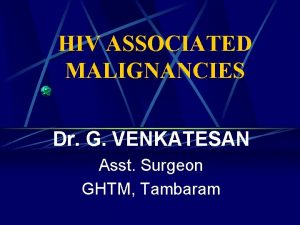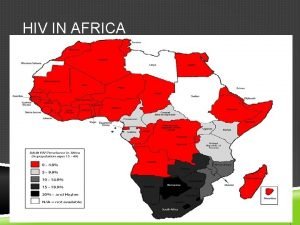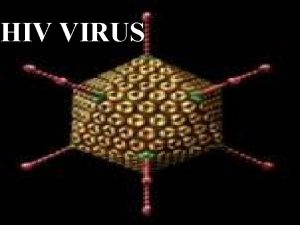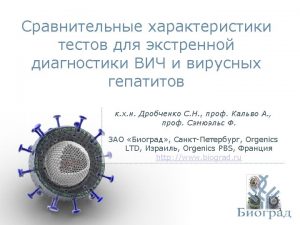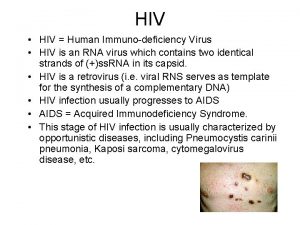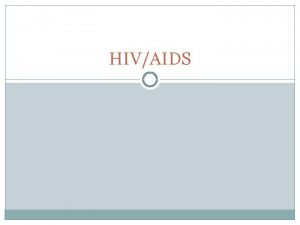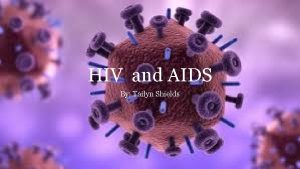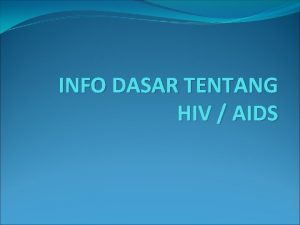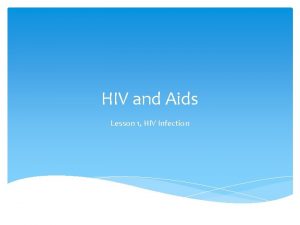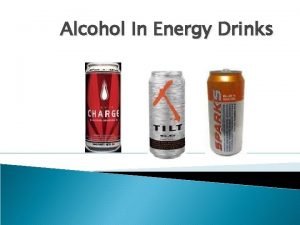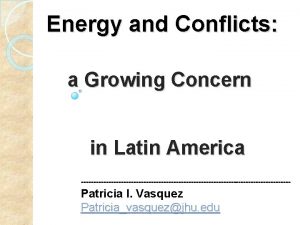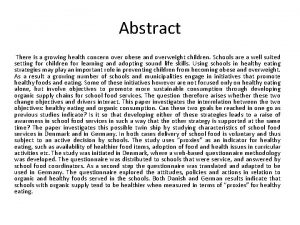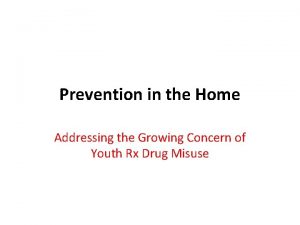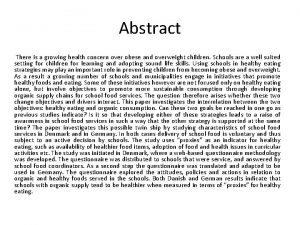Malignancies in HIV A Growing Concern Ronald Mitsuyasu















































- Slides: 47

Malignancies in HIV: A Growing Concern Ronald Mitsuyasu, MD Professor of Medicine Director, UCLA Center for Clinical AIDS Research and Education Group Chairman, AIDS Malignancy Consortium (AMC)

Cancers in HIV Disease AIDS-Defining Virus • Kaposi’s Sarcoma • Non-Hodgkin’s Lymphoma (systemic and CNS) HHV-8 • Invasive Cervical Carcinoma Non-AIDS Defining HPV • Anal Cancer • Hodgkin’s Disease • Leiomyosarcoma (pediatric) HPV • Squamous Conjunctival Carcinoma • Hepatoma HPV (? ) EBV, HHV-8 EBV HBV, HCV

HIV-Associated Cancers: Incidence Pre and Post HAART P<0. 05 Kaposi’s sarcoma Non-Hodgkin’s Lymphoma (systemic) Immunoblastic lymphoma CNS lymphoma P<0. 01 Burkitt’s lymphoma Hodgkin’s disease Cervical cancer Other cancers Pre-HAART (1992 -1996) Post HAART (1997 -1999) Incidence (per 1000/year) International Collaboration on HIV and Cancer. J Natl Cancer Inst. 2000; 92: 1823 -1830.

CASCADE Collaboration: Overall Mortality and Causes of Death Overall Mortality* Causes of Death† Pre-HAART (n=1424) HAART (n=514) 31. 7% Deaths (%) Proportion (%) Pre-HAART 19. 3% 10. 0% 9. 9% HAART 4. 9% 2. 5% 0 5 10 Years Since Seroconversion* 15 OIs 3. 2% Not Hepatitis Specified Liver 2. 5% Malignancy 4. 3% 1. 3% CVD/ DM *n=7680 seroconverters, of whom 1938 died (26%; 1424 pre-HAART and 514 during HAART). †no change in the following causes of death: AIDS-related malignancy, other infections, organ failure, and unknown causes. Smit C, et al. AIDS. 2006; 20: 741 -749.

Non-AIDS Endpoint SMART Study • Randomized trial of continuous viral suppression (VS) vs drug conserving, intermittent HAART (DC), CD 4 250 -350 • N=5472 Study prematurely stopped due to higher deaths and other endpoints in DC Endpoint Number % CVD 79 42 Hepatic 17 12 Renal 11 10 NA Cancer 60* 36 *25% Fatal Silverberg et al. AIDS 2007, 21: 1957 -1963

HIV-Cancers: Overview • Non-AIDS defining malignancies • Anogenital neoplasia • Lymphomas • Kaposi’s Sarcoma

Non-AIDS Defining Cancers NADC

Pathogenesis of NADC • Some are virally-induced cancers, but not all • HIV-tat may transactivate cellular genes or protooncogenes, inhibit tumor suppressor genes • Microsatellite alterations (MA) due to genetic instability in HIV (e. g 6 fold higher number of MA in HIV lung CA over non-HIV)1 • Increase susceptibility to effects of carcinogens (tobacco) • Population differences based on genetics and exposure to carcinogens • Decreased immune surveillance 1 Wistuba, AIDS 1999; 13: 415 -26

Relative Risk for Malignancies in AIDS in USA Strong Association Possible Association Relative Risk Kaposi’s sarcoma Hodgkin’s 7. 6 Overall 73, 000 Multiple myeloma 4. 5 MSM 106, 000 Lip 4. 1 non-MSM 13, 000 Brain 3. 5 Seminoma 2. 9 Cervical cancer 2. 9 Non-Hodgkin’s lymphoma 165 Anal 31. 7 Squamous cell carcinoma 13. 0 Goedert J. Semin Oncol. 2000; 4: 390 -401.

Incidence of Non-AIDS-Defining Malignancies in the HIV Outpatient Study (HOPS) • 7893 HIV patients in Chicago compared to Illinois cancer registry patients • 1992 -2002 • Determined age-, race-, smoking-, and gender- adjusted rates for NADCs: – Increased rates for Hodgkin’s (77. 4), head/neck (10), anorectal (5. 0), melanoma (4. 1), and lung (3. 6) – Excess lung cancers is related primarily to tobacco use – Cancers occur at an earlier age in HIV than non-HIV and in both men and women – No excess risk for breast, colon, or prostate cancer Clifford J Natl Cancer Inst 2005; 97: 425; Engels CROI 2005 Abstract 908; Phelps Int J Cancer 2001; 94: 753; Serraino AIDS 2000; 14: 553; Giordano Clin Infect Dis 2005; 40: 490. Patel, CROI 2004.

Summary of NADCs with Increased Occurrence in USA • Anal • Hodgkin’s Disease: mixed cellularity/lymphocyte -depleted types • Lung – adenocarcinoma – tobacco-related • Testicular mostly seminoma • Skin: basal, squamous cell, melanoma • Multiple myeloma • Leukemia mostly M 4, M 5 • Leiomyosarcoma in pediatrics, RR 1915 (1 in 5000, 8 -14% of all cancers in kids) Chiao EY and Krown SE. Curr Opin Oncol 15: 389 -97, 2003

NADCs: Other Cancers • • • Lip Head and neck cancers Penile Conjunctival Little evidence for breast, colon, prostate and liver cancers occurring at higher rates, although study results vary • In Africa, less increase in NADCs perhaps due to – Underdiagnosis – Deaths due earlier from infections Chaio EY and Krown SE Curr Opin Onc 15: 389 -97, 2003

Why does lung CA do so badly? HIV- Age. Matched HIV- Pre HAART Post HAART HIV+ Number 192 102 97 18 Age 69 45 42 45 Stage 1 -IIIA 32% 10% 25% 6% PS 0 -2 51% 52% 40% Survival (months) >10 4 4. 5 4 Adenocarcinoma 28% 66% 45% 27% Powels, Br J Cancer 2003; 89: 457 -9

Anogenital Cancers

Anogenital Cancers • Invasive cervical carcinoma – Considered an AIDS-defining condition • Anal cancer 1 – Not AIDS defining but very common • HPV involvement 1 -2 – Both derive from premalignant dysplastic lesions due to HPV – Most oncogenic strains: 16, 18, 31, 33, 35, 45 – Repeated infections and infection with multiple HPV strains increase the risk of developing neoplasia 1 Phelps 2 Martin RM, et al. Int J Cancer. 2001; 94: 753 -757. F, et al. Sex Transm Infect. 2001; 77: 327 -331.

Guidelines for assessment of CIN in HIV+ women l Pap smear at initial evaluation l Repeat Pap smear 6 months later l If both negative, can do annual Pap l Low threshold for colposcopy l Role of HPV testing l Screening for women over 18

Treatments for Cervical SIL and Invasive Cervical Cancer Local Disease HSIL Invasive Disease 1, 2 • Cryoablation • Surgery (stage I) • Laser therapy • Radiation therapy • Cone biopsy • Cisplatin or carboplatin • Loop electrosurgical excision procedure (LEEP) • Topical 5 -FU • Trans-retinoic acid • Podophyllin cream • Imiquimod cream • Antiretroviral Therapy (? ) 1 Mitsuyasu 2 Martin RT, et al. Cancer Management. 2006: 609 -632. F, et al. Sex Transm Infect. 2001; 77: 327 -331.

Relative risk of anal cancer in U. S. A. AIDS-cancer registry match study Age HIV+ women HIV+ men <30 134 163 30 -39 12. 2 40 ≧ 40 2. 6 32 All ages 6. 8 37 Frisch et al, JNCI, 2000; 92: 1500 -1510.

Anal Cytology Screening for AIN in HIV-positives Screening Pap Normal ASCUS LSIL HSIL Repeat in 12 months Anoscopy with biopsy No lesion seen LSIL Treat or follow HSIL Treat Chin-Hong PV et al. J Infect Dis. 2004; 90: 2070 -2076.

Treatments for Anal SIL and Carcinoma 1, 2 Anal SIL 1 • Low grade – Repeat high resolution anoscopy every 6 months • Combination chemoradiotherapy – Mitomycin + 5 -fluorouracil/RT – Cisplatin + 5 -fluorouracil/RT • High grade – Surgery • Investigational – Combined chemoradiotherapy + Cetuximab (AMC 045) – Laser, IRC or electrocautery – 80% Trichloroacetic acid – Investigational agents • Cidofovir cream (AMC 046) • Imiquimod 1 Mitsuyasu 2 Martin RT, et al. Cancer Management. 2005: -632. F, et al. Sex Transm Infect. 2001; 77: 327 -331.

Immunization Against HPV § HPV infection induces type-specific immune responses § Promising vaccine candidate: § Virus-like particles (VLP) are recombinant viral capsids that induce type-specific neutralizing antibodies § VLPs are nontoxic and highly immunogenic § Both bivalent (HPV 16, 18) and quadravalent (HPV 6, 11, 16, 18) vaccines available Schiller JT et al. Nat Rev Cancer. 2004; 2: 343 -347.

Phase II Trial of a Quadrivalent HPV Vaccine: Modified Intention–to–Treat (MITT) Efficacy Number of cases Quadravalent: HPV 6, 11, 16, 18 Overall Efficacy: 89% Villa LL et al. Lancet Oncol. 2005; 6: 271 -278.

Lymphomas

Pathology of AIDS-Related Non-Hodgkin’s Lymphoma • Small noncleaved-cell lymphoma – Burkitt’s lymphoma and Burkitt-like lymphoma • Immunoblastic lymphoma (primary CNS) • Diffuse large-cell lymphoma (90% CD 20+) – Large noncleaved-cell lymphoma – CD 30+ anaplastic large B-cell lymphoma • Plasmablastic lymphoma • Advanced stage (>75% III or IV) • Extranodal involvement – Central nervous system, liver, bone marrow, gastrointestinal Tirelli U, et al. AIDS. 2000; 14: 1675 -1688.

Therapeutic Approaches for AIDSRelated Non-Hodgkin’s Lymphoma • Outgrowth of lymphoma treatment in general – Multiple agent, non-cross resistant chemotherapy – Increase dose intensity (infusional therapy, high dose or multiple drugs) – Central nervous system treatment or prophylaxis – Supportive antibiotics and hematopoietic growth factors • • Importance of HAART Use of monoclonal antibodies (rituximab) AMC 010 and 034 • High dose chemotherapy with ASCT

AIDS-NHL Survival: Impact of HAART and EPOCH Besson et al. Blood. 2001; 98: 2339 -2344 Little et al Blood. 2003; 101: 4653 -4659 Sparano et al: 2006, 10 th ICMAOAI, Bethesda

AIDS Malignancies Consortium Study 010: CHOP With or Without Rituximab • Phase II trial – 149 patients CHOP + CHOP Rituximab Alone Number of patients 99 51 Complete response (%) 58 48 Median time to response (weeks) 11. 0 10. 5 Median event-free survival (weeks) 52 51 • Patients restaged every Death due to 2 cycles infection 13* 1 • Median F/U 137 wk 139 110 – Median CD 4 count: 133 cells/mm 3 • Regimens – Rituximab (day 1) + CHOP (day 3) – CHOP Median overall survival (weeks) *P=0. 035 vs CHOP alone. Kaplan LD, et al. Blood 2005; 106: 1538 -1543

Dose-Adjusted EPOCH (NCI) in HIV-Infected Patients • Dose-adjusted EPOCH chemotherapy – Etoposide 200 mg/m 2 (96 -hour infusion) – Vincristine 1. 6 mg/m 2 (96 -hour infusion) – Doxorubicin 40 mg/m 2 (96 -hour infusion) – Prednisone 60 mg po on days 1– 5 – Cyclophosphamide IV on day 5 • CD 4 <100 cells/mm 3: 187 mg/m 2 • CD 4 >100 cells/mm 3: 375 mg/m 2 • Dose adjusted in cycles 2 through 6 to a maximum of 750 mg/m 2 Little RF, et al. Blood. 2003; 101: 4653 -4659.

Response to Dose-Adjusted EPOCH in HIV-Infected Patients • Median follow-up CD 4 (cells/mm 3) – 53 months • Median CD 4 – 190 cells/mm 3 • Not prognostic – Tumor proliferation – p 53 overexpression <100 >100 Total Number of patients 16 23 39 Complete response (%) 56 87 79 Relapse 2 0 2 Progression-free survival (%) 73 93 87 Overall survival (%) 36 87 60 Little RF, et al. Blood. 2003; 101: 4653 -4659.

Progression-Free and Overall Survival with EPOCH Little, R. F. et al. Blood 2003; 101: 4653 -4659

Kaplan-Meier analysis of Overall Survival in 20 patients after ASCT Median Followup: 32 (5. 5 -70) mos Krishnan, A. et al. Blood 2005; 105: 874 -878

Primary CNS Lymphomas in HIV-Infected Patients • Incidence: <5% of AIDS patients. Now very rare • Diagnostic approaches – Cranial CT or MRI scan • Most important differential diagnosis: toxoplasmosis – Stereotatic brain biopsy essential for diagnosis • When biopsy not possible, EBV-PCR of CSF is useful, 100% sensitive, 80% specific • Therapeutic approaches – Traditional: radiation (4000 -5000 c. Gy)- 10% 1 yr survival – High-dose methotrexate based chemotherapy • Non-AIDS patients: shows promise – High-dose ZDV + GCV +/- IL-2 may have benefit (JAIDS 1999; 15: 713 -19)

Primary Effusion Lymphomas in HIV-Infected Patients • B-cell non-Hodgkin’s lymphoma – Most cases are dually infected with HHV 8 and EBV – Median survival: 6 months • Traditional treatment: CHOP • High-dose methotrexate plus CHOP – Retrospective series of 7 patients treated: • 3 in complete remission 18, 26, and 78 months after diagnosis • 3 died with progressive PEL • 1 achieved complete remission, but died with plasmablastic non -Hodgkin’s lymphoma at 9 months Boulanger E, et al. Am J Hematol. 2003; 73: 143 -148.

Hodgkin’s Disease • Association with HIV-infection – Hodgkin’s disease: RR: 5 to 30 – Non-Hodgkin’s disease: RR: 24 to 165 • Patients with HIV present with: – B symptoms (70% to 96%), worse histology, higherstage tumor (74% to 92% are III or IV), bone marrow involvement (40% to 50%), pancytopenia • Good response to MOPP/ABV – Complete response: 74. 5% – 2 -year disease-free survival: 62% – Early better results with Stanford V and BEACOPP Gerard L, et al. AIDS. 2003; 17: 81 -87.

Kaposi’s Sarcoma

Kaposi’s Sarcoma • One of the first recognized AIDS-defining illnesses • Vascular tumor that may involve mucocutaneous, lymphatic, gastrointestinal, and pulmonary sites – Human herpesvirus-8 (HHV 8) or KSHV • HHV 8 – DNA virus found in both HIV+ and HIV- KS. – Tropism for B cells and endothelial cells, high titers in saliva – Also associated with primary effusion lymphoma, Castleman’s disease, and angioimmunoblastic lymphadenopathy in HIV – Genome codes for viral homologs of human proteins involved in cell cycle regulation and signaling • HIV- and Kaposi’s sarcoma-induced angiogenic and inflammatory cytokines also stimulate Kaposi’s sarcoma cell growth




Pulmonary KS has Poor Prognosis 5 -year overall survival: p. KS— 49% vs KS— 82% Median survival: Pre-HAART- 4 mos, HAART- 20 mos Palmieri et al HIV Med 2006, 7, 291 -293

Treatments for Kaposi’s Sarcoma Local 1 Systemic 1, 2 • Radiation therapy • Antiretroviral therapy • Photodynamic (laser) therapy • Liposomal anthracyclines • Intralesional chemotherapy • Paclitaxel • Cryotherapy • Vinca alkaloids • Alitretinoin gel – • Alpha Interferon • Bleomycin 9 -cis retinoic acid (top) 1 Levine AM, et al. Eur J Cancer. 2001; 37: 1288 -1295. 2 Mitsuyasu RT, et al. Cancer Management. 9 th Ed. 2005: 609 -632.

Indication for Systemic Therapy • Widespread skin involvement (usually more than 25 lesions) • Extensive cutaneous KS unresponsive to local treatment or HAART • Extensive edema • Symptomatic visceral involvement • Patients request for rapid tumor control

KS Response to HAART Study N Response Survival HAART+ 20 14(71%) 31 mo HAART- 28 3(13%) 7 mo 21 10(48%) Paparizos 26 22(85%) Cattelan et al 14 12(86%) Dupont et al 19 10(53%) Leitch et al Gill J et al HAART+

Potential for HHV 8 -Directed Therapy for Kaposi’s Sarcoma • Gamma herpes viruses (eg, HHV 8 and Epstein-Barr) can transform normal cells into cancerous ones • Foscarnet – May induce regression of tumors in early Kaposi’s sarcoma and in multicentric Castleman’s disease • Cidofovir 1 – No activity in a small number of patients • Valproic acid (AMC 038) – Upregulates lytic HHV 8 genes and may enhance CTLs • Depsipeptide, histone deacetylase inhibitor – Effective in inducing cell death in HHV-8 infected PEL • Bortezimib (Velcade) +/- Ganciclovir 1 Little RF, et al. J Infect Dis. 2003; 187: 149 -153.

Pathogenesis of KS KSHV LANA v-FLIP v-cyclin v-GPCR K 1, K 3, K 5 v-MIP cdk 6 v-IRFs, v. IL 6, V-Bcl-2 Rb p. Rb PDGF VEGF PDGFR ckit Angiogenesis Tat Inflammatory Cytokines IL-1 b IL-6 TNF g IFN b. FGF HIV

Summary • As patients live longer with HIV, morbidity and mortality from cancers are increasing • We must be able to quantify and characterize cancers in HIV, as it may vary in different populations around the world • Treatment of malignancies in HIV should be vigorously and appropriate to the situation • Side effects associated with HAART and cancer therapy should be treated/prevented • Prevention strategies for virally-associated malignancies need to be investigated • Effective and feasible treatments are under development and need to be tested worldwide

Prevention and Treatment of Malignancies in HIV Thank you Ronald Mitsuyasu, MD Director, UCLA CARE Center Chairman, AIDS Malignancy Consortium
 Ronald mitsuyasu
Ronald mitsuyasu Ronald mitsuyasu
Ronald mitsuyasu Ronald mitsuyasu
Ronald mitsuyasu Jaringan limfoid
Jaringan limfoid Lymphoma case presentation
Lymphoma case presentation Growing concern grade 11, 1150l
Growing concern grade 11, 1150l Algorithm efficiency is typically a concern for
Algorithm efficiency is typically a concern for Basic accountin
Basic accountin The going concern assumption assumes that the business
The going concern assumption assumes that the business Data quality is always a concern with secondary data
Data quality is always a concern with secondary data Age concern gosport
Age concern gosport Prime concern
Prime concern Water pollution and unequal distribution illustration
Water pollution and unequal distribution illustration Iowa concern hotline
Iowa concern hotline Going concern princip
Going concern princip Isa 500 summary
Isa 500 summary Explain the term accountancy of lawyers
Explain the term accountancy of lawyers The owners of a small manufacturing concern have hired
The owners of a small manufacturing concern have hired Going on concern principle
Going on concern principle Why is water pollution of great concern in southwest asia
Why is water pollution of great concern in southwest asia Cbam levels of use
Cbam levels of use Going concern princip
Going concern princip Accounting for non trading organisation
Accounting for non trading organisation Thematic concern
Thematic concern Going concern assumption
Going concern assumption Belarusian state food industry concern
Belarusian state food industry concern Introduction of sole proprietorship
Introduction of sole proprietorship Going concern principle
Going concern principle Sole trading concern features
Sole trading concern features Accounting as the language of business
Accounting as the language of business Central city concern housing office
Central city concern housing office Accounting conventions
Accounting conventions Memo spacing
Memo spacing Toyota concern
Toyota concern Hiv virus
Hiv virus What does hiv diarrhea look like
What does hiv diarrhea look like Hiv
Hiv Hiv lifecycle
Hiv lifecycle Basic hiv course
Basic hiv course How does hiv get into the urethra
How does hiv get into the urethra Hiv
Hiv Hiv risk factors
Hiv risk factors Hiv receptor
Hiv receptor Abcde hiv
Abcde hiv Why do the bodys antibodies fail to protect people from hiv
Why do the bodys antibodies fail to protect people from hiv Syptoms of hiv
Syptoms of hiv Cytomegalavirus
Cytomegalavirus Kasus hiv aids
Kasus hiv aids
